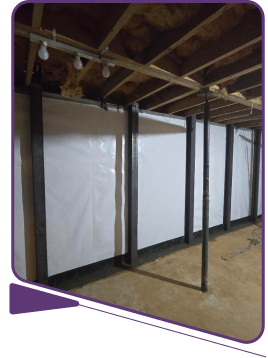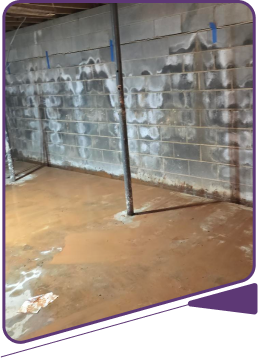When your basement walls start showing signs of bowing, leaning, or cracking, it’s essential to address the issue promptly to maintain the structural integrity of your home. RhinoLift Foundation Solutions uses a tried-and-true solution for these problems: Wall Anchors. Our team uses wall anchors to stabilize bowed and leaning basement walls in Charlotte, NC, and the surrounding areas.
Wall Anchors Services in Charlotte, NC

UNDERSTANDING WALL ANCHORS
Wall anchors are a reliable and effective method for reinforcing and stabilizing basement walls that have succumbed to external pressure or foundation settlement. These anchors are designed to counteract the forces pushing against your basement walls, preventing further damage and restoring stability. Here’s why wall anchors are the anchor of choice for basement repairs:
- Proven Reliability: Wall anchors have been used for decades and are a well-established solution for repairing bowing or leaning basement walls.
- Minimally Invasive: The installation process for wall anchors is relatively non-disruptive, allowing for repairs without significant excavation or structural changes.
- Versatile: Wall anchors can be installed both on the interior and exterior of your basement, making them suitable for a variety of wall types and conditions.
COMMON BASEMENT ISSUES ADDRESSED BY WALL ANCHORS
Wall anchors are a versatile solution capable of addressing various basement issues, including:
- Bowing Walls: Wall anchors are used to counteract the external pressure causing basement walls to bow inward, gradually restoring them to their original position.
- Leaning Walls: If your basement walls are leaning or tilting due to soil pressure or foundation settlement, wall anchors provide the necessary support to prevent further movement.
- Cracking Walls: Wall anchors can help stabilize walls with cracks by distributing the pressure evenly, preventing the cracks from worsening. Once the walls are stabilized our team will seal the cracks preventing further cracking and water intrusion.

THE WALL ANCHOR INSTALLATION PROCESS
At RhinoLift Foundation Solutions, our wall anchor installation process is meticulous and efficient to ensure that your basement walls regain their stability:
- Initial Assessment: Our experienced technicians start with a thorough assessment of your basement’s structural issues to determine the optimal placement of wall anchors.
- Excavation (if necessary): In some cases, excavation may be required to install the exterior wall anchor plate. This step is done with care and precision to minimize disruption.
- Anchor Installation: Steel anchor rods are driven through small holes in your basement walls and into the stable soil or load-bearing strata beyond. On the exterior, earth anchors are embedded in the ground and connected to the anchor rods.
- Tension Adjustment: The anchor rods are gradually tightened to provide the necessary lateral support, pulling the basement wall back into place.
CONTACT RhinoLift Foundation Solutions FOR BOWED WALL REPAIR SOLUTIONS
Don’t wait for structural issues to worsen; act now to preserve your basement’s stability and safety. Contact RhinoLift Foundation Solutions today at 980-480-3215 to schedule an appointment for wall anchor installation and basement repairs. Our expert team is ready to assess your needs and provide a customized solution. Request a free basement inspection today!
Basement walls can be subjected to various forces that can cause damage over time, such as soil pressure, hydrostatic pressure, and inadequate construction. As a result, basement walls may develop cracks, bowing, or leaning. Wall anchors are an effective repair method that can stabilize and reinforce the basement walls, preventing further damage.
SIGNS AND SYMPTOMS OF BASEMENT DAMAGE
There are several signs and symptoms that may indicate the need for basement repair:
- Cracks in the Basement Walls – This is one of the most obvious signs of basement damage. Cracks can appear in a variety of shapes and sizes, ranging from hairline cracks to larger, more severe cracks.
- Bowing or Leaning Walls – If the basement walls are bowing or leaning, this may be a sign of more serious structural damage.
- Water Damage – Water damage in the basement can lead to mold and mildew growth, which can cause health problems for occupants of the home.
- Sagging Floors – If the floors in the basement are sagging or uneven, this may be a sign of foundation settling or other structural issues.
- Sticking Doors or Windows – If doors or windows in the basement are difficult to open or close, this may be a sign of foundation movement.
Causes of Basement Damage
Causes of Basement Damage
- Water Damage – Water intrusion can cause damage to the basement walls and weaken the structure over time.
- Soil Pressure – Soil pressure around the basement walls can cause them to bow or lean inward.
- Hydrostatic Pressure – Excessive groundwater around the basement walls can exert hydrostatic pressure, causing them to crack or bow.
- Inadequate Construction – If the basement walls were not properly constructed or the materials used were of poor quality, this can contribute to basement damage.
Wall Anchor Repair Methods
Wall Anchor Repair Methods
- Assess the Damage – A professional contractor will assess the extent of the damage and determine if wall anchors are the appropriate repair method.
- Prepare the Area – The area around the basement walls must be cleared and prepared before the wall anchors are installed.
- Install the Wall Anchors – Wall anchors are installed by drilling holes in the basement walls and inserting steel rods or plates. The rods are then connected to a steel plate or wall plate outside the basement walls.
- Tighten the Wall Anchors – The wall anchors are tightened over time to slowly straighten the basement walls.
- Fill the Holes – Once the wall anchors are installed and tightened, the holes in the basement walls are filled with grout or cement.
Wall anchors are an effective and long-lasting repair method for stabilizing and reinforcing basement walls. It is important to work with a professional contractor who has experience with this type of repair to ensure that the repair is done properly and effectively.
Contact our expert team
Our Partner Brands




©2025 RhinoLift Foundation Solutions.
All Rights Reserved.
Privacy Policy.
NC GC License: #99872 SC GC License: #124903.
Web Design and Internet Marketing by RYNO Strategic Solutions
